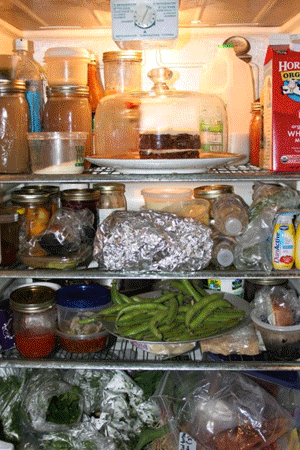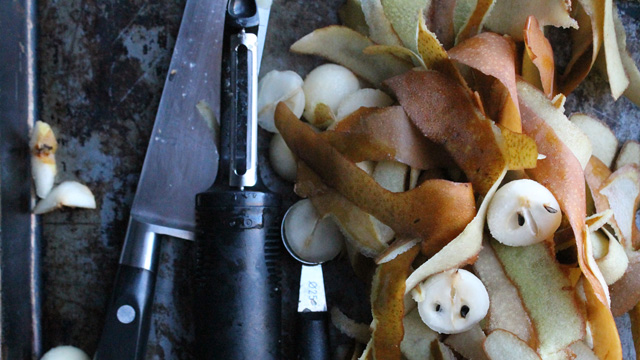Eugenia Bone’s The Kitchen Ecosystem
The Kitchen Ecosystem is a way of looking at the food you buy, prepare, and discard, and understanding why it tastes the way it does.
I’ve learned that almost every ingredient I approached could be used in three ways: I could eat some fresh, preserve some, and use the waste stream to boost the flavor of a new dish featuring another ingredient, creating, in essence, a kind of perpetual pantry. Preserved foods and byproducts like stocks made from the waste stream of cooking those foods add flavor to the next dish, which in turn supports a new generation of preserved foods and waste stream-enhanced flavors, and on, and on.
I also replace the commercial condiments I use regularly with homemade condiments, because whenever I use homemade mayo instead of commercial mayo in a recipe, it tastes better. Open the fridge door: almost everything on there can be made pretty easily. It used to be that when I was out at the market shopping for, say, beef to roast, and knew I needed horseradish, I could never remember if I had any. So I’d buy a jar, and then when I got home I’d realize I have one in the door of the fridge and another in the pantry from the last time I made this same mistake. But once I started to make my own horseradish, for some reason I never forgot if I had it.
Cooking is not a full time job for me. If a recipe is convoluted or really labor intensive, it’s very hard for me to fold it into my lifestyle. However, if I can preserve or glean useable flavoring agents from the waste stream of foods while I am preparing dinner anyway, then I’ll do it. Often that means making nanobatches: I don’t turn up my nose at making just a pint of stock. Why not? It’s handy. And over time, my pantry and freezer and fridge have become loaded with a small army of preserved foods and useful byproducts that lend flavor and convenience to the daily job of making dinner.
I have what amounts to a kitchen ecosystem: a set of interconnected foods that defines my palate, which is mostly Mediterranean, primarily Italian. It also reflects my politics because I believe in supporting regional, organic food producers; and my purse because by eating regionally I keep my dollars local and what’s more, by preserving I keep my dollars local year round. The small chores of maintaining an array of homemade products actually saves me time and money when it comes to putting dinner together. Often, all I have to do is buy the main fresh ingredient, like a chicken or a bunch of beets, and I can rustle up a meal, usually two.
 Shopping is as important to cooking as heat. If you use good stuff, you don’t need elaborate recipes, and you don’t even have to be a good cook. I guarantee that if you use fresh ripe locally grown vegetables and fruits, animals that have been raised with care, and wild products your regular recipes will taste better. But beyond this common sense approach, I have come to believe that binging on seasonal foods is the healthiest and most natural way to eat. When my daughter was little she’d eat avocados for a month, then switch to a month of eating hot dogs, and so on. I worried she wasn’t getting proper nutrition. But when I consulted her pediatrician he said that if I looked at what she ate over the course of a year, I would see she was actually getting a pretty well rounded diet. This was a revelation and it reinforces the wisdom of seasonal eating. The only way you can get a range of foods in a daily diet is if you eat some foods out of season, and those foods must, of course, be picked early and processed to accommodate the stress of shipping. Since out-of-season foods are less nutritious than seasonal foods, I think the whole idea of a daily food pyramid is bogus.
Shopping is as important to cooking as heat. If you use good stuff, you don’t need elaborate recipes, and you don’t even have to be a good cook. I guarantee that if you use fresh ripe locally grown vegetables and fruits, animals that have been raised with care, and wild products your regular recipes will taste better. But beyond this common sense approach, I have come to believe that binging on seasonal foods is the healthiest and most natural way to eat. When my daughter was little she’d eat avocados for a month, then switch to a month of eating hot dogs, and so on. I worried she wasn’t getting proper nutrition. But when I consulted her pediatrician he said that if I looked at what she ate over the course of a year, I would see she was actually getting a pretty well rounded diet. This was a revelation and it reinforces the wisdom of seasonal eating. The only way you can get a range of foods in a daily diet is if you eat some foods out of season, and those foods must, of course, be picked early and processed to accommodate the stress of shipping. Since out-of-season foods are less nutritious than seasonal foods, I think the whole idea of a daily food pyramid is bogus.
So I have embraced the idea of a well-rounded annual diet, and jag on seasonal foods while they are at their nutritional peak. And just to keep it interesting and tasty, I augment my local and seasonal diet with preserved foods, put up when they were best sourced and at their most fresh.
Whatever is in your kitchen, that’s your ecosystem. You don’t have to replace everything in the door of your fridge with homemade versions in order to be successful. Just replace the stuff you use often and you will see a significant improvement in the taste of your food. Simply put, there is a direct correlation between the amount of homemade and preserved stuff you have on hand to cook with, and the tastiness of your food. The more complex your Kitchen Ecosystem, the better tasting your food will be, regardless of the recipe. This is the secret to tasty food.
I wrote a book, The Kitchen Ecosystem, chronicling the recipes–the fresh, preserved, byproducts, and condiments–that I’ve been doing for years. But I am not done! This is the way I cook, and I am always trying new things.
 The Kitchen Ecosystem
The Kitchen Ecosystem